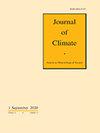与厄尔尼诺-南方涛动有关的东非沿岸洋流的年际变化
IF 4
2区 地球科学
Q1 METEOROLOGY & ATMOSPHERIC SCIENCES
引用次数: 0
摘要
摘要 东非沿岸流(EACC)是热带南印度洋的重要西边界流,在印度洋的大洋环流和生物地球化学循环中发挥着重要作用。本研究探讨了东非海岸流的年际变化及其动力学机制。结果表明,1993-2017 年期间,EACC 的年际变化与厄尔尼诺-南方涛动(ENSO)有关。EACC与Niño3.4指数呈明显的正相关,相关系数为0.65,滞后Niño3.4指数18个月。在厄尔尼诺(拉尼娜)事件的衰减阶段,负(正)海平面异常(SLA)以上升流(下沉流)罗斯比波的形式从东南印度洋向西传播到西南印度洋,然后在地转平衡下,由于东非沿岸的带状 SLA 梯度,使 EACC 增强(减弱)。SLA 在向西传播的过程中,在东南印度洋逐渐减弱,但在西南印度洋受局地风应力卷曲异常的影响而增强。这项研究可以加深我们对热带南印度洋西部边界流与大尺度厄尔尼诺/南方涛动海气过程之间关系的理解,对东非沿岸海洋渔业和生态系统管理具有重要意义。本文章由计算机程序翻译,如有差异,请以英文原文为准。
Interannual variability of the East African Coastal Current associated with the El Niño-Southern Oscillation
Abstract The East African Coastal Current (EACC) is an important western boundary current of the tropical South Indian Ocean and plays an important role in the ocean circulation and biogeochemical cycles in the Indian Ocean. This study investigates the interannual variability of the EACC and its dynamical mechanisms. The result shows that the EACC has interannual variability associated with the El Niño-Southern Oscillation (ENSO) during 1993-2017. The EACC shows a significantly positive correlation with the Niño3.4 index with a correlation coefficient of 0.65, lagging the Niño3.4 index by 18 months. During the decaying phases of El Niño (La Niña) events, the negative (positive) sea level anomaly (SLA) propagates westward as upwelling (downwelling) Rossby waves from the southeast Indian Ocean to the southwest Indian Ocean, and then strengthens (weakens) the EACC due to zonal SLA gradient off the East African coast under geostrophic equilibrium. The SLA gradually weakens in the southeast Indian Ocean during its westward propagation but strengthens in the southwest Indian Ocean promoted by local wind stress curl anomaly. This study can improve our understanding of the relationship between the western boundary current of the tropical South Indian Ocean and large-scale ENSO air-sea processes, and is important for managing marine fisheries and ecosystems on the East African coast.
求助全文
通过发布文献求助,成功后即可免费获取论文全文。
去求助
来源期刊

Journal of Climate
地学-气象与大气科学
CiteScore
9.30
自引率
14.30%
发文量
490
审稿时长
7.5 months
期刊介绍:
The Journal of Climate (JCLI) (ISSN: 0894-8755; eISSN: 1520-0442) publishes research that advances basic understanding of the dynamics and physics of the climate system on large spatial scales, including variability of the atmosphere, oceans, land surface, and cryosphere; past, present, and projected future changes in the climate system; and climate simulation and prediction.
 求助内容:
求助内容: 应助结果提醒方式:
应助结果提醒方式:


